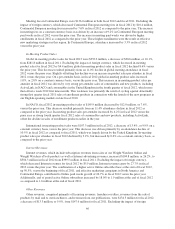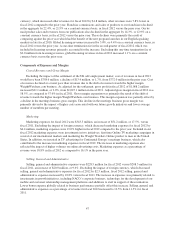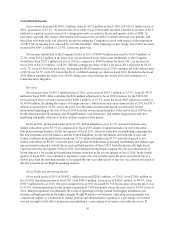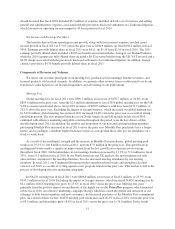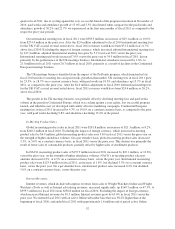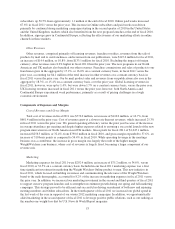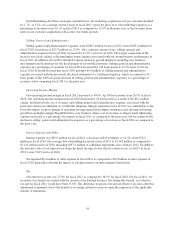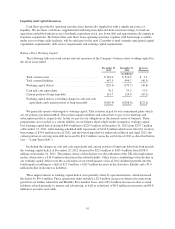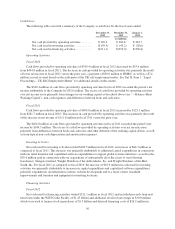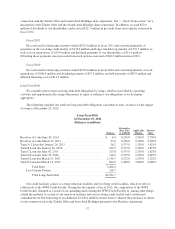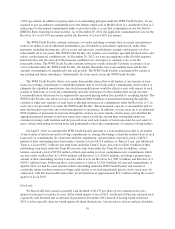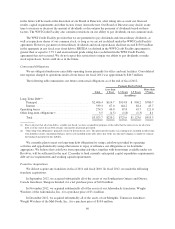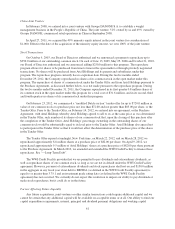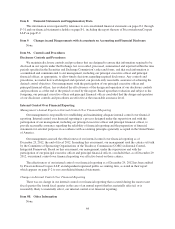WeightWatchers 2012 Annual Report Download - page 71
Download and view the complete annual report
Please find page 71 of the 2012 WeightWatchers annual report below. You can navigate through the pages in the report by either clicking on the pages listed below, or by using the keyword search tool below to find specific information within the annual report.
Liquidity and Capital Resources
Cash flows provided by operating activities have historically supplied us with a significant source of
liquidity. We use these cash flows, supplemented with long-term debt and short-term borrowings, to fund our
operations and global initiatives, pay dividends, repurchase stock, pay down debt and opportunistically engage in
franchise acquisitions. We believe that cash flows from operating activities, together with borrowings available
under our revolving credit facilities, will be sufficient for the next 12 months to fund currently anticipated capital
expenditure requirements, debt service requirements and working capital requirements.
Balance Sheet Working Capital
The following table sets forth certain relevant measures of the Company’s balance sheet working capital for
the fiscal years ended:
December 29,
2012
December 31,
2011
Increase/
(Decrease)
(in millions)
Total current assets ................................ $218.0 $ 214.5 $ 3.5
Total current liabilities ............................. 447.9 494.2 (46.3)
Working capital deficit ............................. (229.9) (279.7) (49.8)
Cash and cash equivalents ........................... 70.2 53.2 17.0
Current portion of long-term debt ..................... 114.7 124.9 (10.2)
Working capital deficit, excluding change in cash and cash
equivalents and current portion of long-term debt ...... $(185.4) $(208.0) $(22.6)
We generally operate with negative working capital. This is driven in part by our commitment plans which
are our primary payment method. These plans require members and subscribers to pay us for meetings and
subscription products, respectively, before we pay for our obligations in the normal course of business. These
prepayments are recorded as a current liability on our balance sheet which results in negative working capital.
Our working capital deficit declined $49.8 million to $229.9 million at December 29, 2012 from $279.7 million
at December 31, 2011. After making scheduled debt repayments of $124.8 million which were offset by revolver
borrowings of $30.0 million in fiscal 2012, and the borrowings that we undertook in March and April 2012, the
current portion of our long-term debt decreased by $10.2 million versus the end of fiscal 2011 as described below
(see “—Long-Term Debt”).
Excluding the changes in cash and cash equivalents and current portion of long-term debt from both periods,
the working capital deficit at December 29, 2012 decreased by $22.6 million to $185.4 million from $208.0
million at December 31, 2011. The primary driver of this decline was the settlement of the UK self-employment
matter, which drove a $36.4 million reduction in the related liability. Other factors contributing to this decline in
our working capital deficit were the acceleration of our fourth quarter of fiscal 2012 dividend payment into the
fourth quarter resulting in a shift of $12.9 million, a $10.7 million decrease in the derivative liability and a $1.6
million decline in income tax liabilities.
These improvements in working capital deficit were partially offset by operational items, which increased
the deficit by $39.0 million. These operational items included a $2.4 million increase in deferred revenue from
growth in our Online subscriber and Monthly Pass member bases and a $25.2 million increase in other accrued
liabilities related primarily to interest and advertising, as well as reductions of $6.6 million in inventory and $4.8
million in accounts receivable.
55



